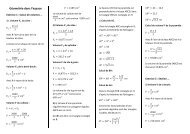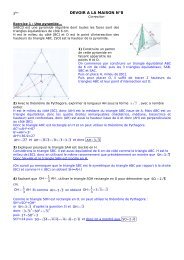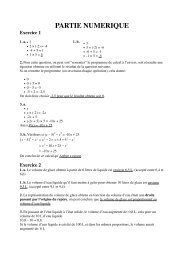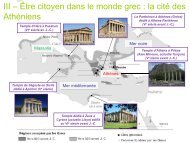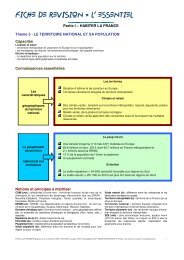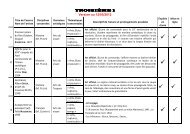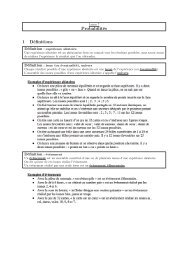Partie 1 : L'activité interne du globe ° Les séismes sont des ...
Partie 1 : L'activité interne du globe ° Les séismes sont des ...
Partie 1 : L'activité interne du globe ° Les séismes sont des ...
Create successful ePaper yourself
Turn your PDF publications into a flip-book with our unique Google optimized e-Paper software.
<strong>Partie</strong> 1 : L’activité <strong>interne</strong> <strong>du</strong> <strong>globe</strong>Chapitre 1 : <strong>Les</strong> <strong>séismes</strong>Acquis :- La surface de la Terre est en permanence remodelée par l’érosion <strong>des</strong> roches qui constituent lepaysage- Au cours <strong>des</strong> temps géologiques, les paysages ont évolué et les témoins de cette évolution <strong>sont</strong>les roches sédimentaires.Vidéo « reportage séisme Japon <strong>du</strong> 11/03/2011 » 5min 16Pb : Quelles <strong>sont</strong> les manifestations <strong>des</strong> <strong>séismes</strong> à la surface de la Terre ?I/ <strong>Les</strong> manifestations <strong>des</strong> <strong>séismes</strong> à la surface <strong>du</strong> <strong>globe</strong>Vidéo : « C’est pas sorcier sur les <strong>séismes</strong> », 1 ère partie reportage sur le tremblement de terre deTurquie. 12 minutes.Activité 1 : Questionnement sur le visionnage <strong>du</strong> vidéogramme afin de mettre en évidence lesmanifestations d’un séisme.Activité 2 : La mesure <strong>des</strong> effets d’un séismeÉchelle EMS (Echelle Macrosismique européenne ou European Macrosismic Scale) et document surl’échelle de Richter.Bilan :<strong>°</strong> <strong>Les</strong> <strong>séismes</strong> <strong>sont</strong> <strong>des</strong> évènements brutaux qui se manifestent par <strong>des</strong>secousses de <strong>du</strong>rée et d’intensité variable.<strong>°</strong> Ils <strong>sont</strong> susceptibles d’entraîner la <strong>des</strong>truction de nombreux bâtimentset font de nombreuses victimes dans les zones habitées.<strong>°</strong> L’importance <strong>des</strong> <strong>des</strong>tructions correspond à l’intensité <strong>des</strong> <strong>séismes</strong> etest mesurée par l’échelle EMS-98. La magnitude est indiquée par l’échellede Richter et mesure l’énergie libérée par le séisme.<strong>°</strong> À la surface de la Terre, les <strong>séismes</strong> changent l’aspect <strong>du</strong> paysage endécalant les terrains de part et d’autres de cassure ou faille.Pb : Comment expliquer la survenue d’un séisme ?
chosen for high throughput and reliability. To re<strong>du</strong>ce theturnaround overhead for higher throughput, clustered reservationis preferred; on the other hand, to re<strong>du</strong>ce the serviceinterval for lower latency, a scattered reservation is better.Thus, it is necessary to take TxRate, retry limit and reservationjointly into account to meet the stringent requirementon bandwidth, reliability and latency for high-qualityvideo streaming. To the best of our knowledge, this is thefirst work reported in open literature on the performance ofvideo streaming over UWB networks with an experimentbased,application-oriented approach.The reminder of this paper is structured as follows. Webriefly examine the technologies available for high-qualityvideo streaming and review the related work on UWB inSection 2. We outline the testbed configuration and evaluationmethodology in Section 3, with performance analysisin Section 4 and followed by throughput, latency and videoperformance results in Section 5. We further discuss the intrinsictradeoffs in physical and MAC layers for high-qualityvideo streaming in Section 6. Section 7 conclu<strong>des</strong> the paperwith the direction of future work.2. BACKGROUND AND RELATED WORK2.1 IEEE 802.11 WLANCurrently, IEEE 802.11 [3] is the dominant technology forWLAN <strong>du</strong>e to its low cost, easy deployment and high flexibility.Most portable devices now have WLAN interfaces embeddedto support one or more mo<strong>des</strong> of IEEE 802.11a/b/g.In theory, IEEE 802.11b can support raw data rate up to 11Mbps and 802.11a/g up to 54 Mbps, which appears to sufficefor high-quality video streaming. However, <strong>du</strong>e to thehigh overhead in IEEE 802.11 physical and MAC layers, lessthan 50% of the raw data rate is available to the applicationlayer. Newer technologies, such as IEEE 802.11n, are emerging,but they are still at a very early stage and not widelyavailable yet, so here we just discuss IEEE 802.11a/b/g.In a household environment, cross-room wireless signalsare attenuated and reflected by floors, walls, doors and movingobjects such as human beings and pets, which re<strong>du</strong>cesthe received signal strength. Also, IEEE 802.11 devices areworking in the same 2.4 and 5 GHz unlicensed frequencybands as other home appliances such as cordless phones andmicrowave ovens, which intro<strong>du</strong>ces interference and furtherre<strong>du</strong>ces the received signal-to-noise ratio (SNR). Given thelimited number of channels available, it is not unusual to seeIEEE 802.11 devices working in a low SNR condition withlimited capacity. [4] points out that the average throughputof IEEE 802.11g devices in a household environment isabout 10 Mbps <strong>du</strong>e to high attenuation, interference andshadowing, which makes it less ideal for high-quality videostreaming, especially with multiple video streams.IEEE 802.11 MAC, even in 802.11n, is mainly based onCarrier Sense Multiple Access with Collision Avoidance, andeach device has equal probability to access the channel. Dueto channel contention, devices are constrained by the onewith the lowest date rate, and some devices have to waita relatively long time to access the channel. Obviously,contention-based MAC is not suitable for real-time applicationssuch as IPTV that have stringent delay and jitter requirement.Contention-based MAC also re<strong>du</strong>ces achievablethroughput <strong>du</strong>e to channel idle and collision times. IEEE802.11e Enhanced Distributed Channel Access (EDCA) [3]is proposed to prioritize channel access and targets at multimediaapplications. However, EDCA is a statistical priorityscheme and cannot guarantee the performance for high prioritytraffic and may starve the low priority one.2.2 Ultra-Wide Band TechnologiesUWB is a radio technology that can be loosely definedas any wireless transmission schemes with bandwidth morethan 25% of its center frequency, or more than 500 MHz [6].There are two camps of UWB, DS-UWB and MBOA-UWB.DS-UWB, referred to as Direct Sequence UWB, is basedon Direct Sequence Spread Spectrum (DSSS) technology.MBOA-UWB, which eventually became WiMedia UWB, isbased on the combination of Time-Frequency Coding (TFC)and Orthogonal Frequency-Division Multiplexing (OFDM)technology. Here we focus on WiMedia UWB as it nowbecomes commercially available off the shelf.UWB has a few unique features to make it a better candidatefor high-quality video streaming: ultra wide band, highdata rate, and low power emission. WiMedia UWB uses a528 MHz band with TFC hopping in the 3.1 to 10.6 GHzfrequency range, which enables many more channels thanIEEE 802.11 to accommodate more device groups. Withsuch a wide band, WiMedia UWB can support raw datarate up to 480 Mbps and potentially to 1,000 Mbps, evenwith lower SNR. By transmitting at a very low power level,UWB has very little interference to other devices, and is lesssusceptible to interference from other devices as well. Lowpower consumption also means better energy conservationfor battery-powered portable consumer electronics.In addition to the physical layer features mentioned above,UWB MAC has its own features to further benefit highqualityvideo streaming. WiMedia [7] has two types of MACschemes: Distributed Reservation Protocol (DRP) and PrioritizedContention Access (PCA). Time <strong>du</strong>ration in WiMediaMAC is equally divided into superframes of 65 ms each,and each superframe has 256 Medium Access Slots (MAS).The first 32 slots can be used for Beacon Period (BP), <strong>du</strong>ringwhich each UWB device can broadcast and inform othersabout the slots in the following Data Period (DP) it reservesfor exclusive access. Consequently, in the reserved slots, the“owner” device transmits at the beginning of the slot withoutcontending for the channel, and others have to wait fortheir reserved slots. DRP provi<strong>des</strong> guaranteed access andperformance. For unreserved DP slots within the same superframe,each device contends for the channel with PCA.PCA is similar to EDCA with prioritized channel access.2.3 Related WorkThere are a few efforts reported in the literature on UWBprototyping and experimentation, but they mainly focus onthe physical layer with proprietary software for demo purpose.For example, [8] presented a wireless display system totransport raw, uncompressed analog video signals throughUWB from a smartphone to a data projector. [9] implementeda UWB-based wireless communication system usingmulti-FPGA hardware and discrete RF <strong>des</strong>ign to achieve amaximum data rate of 110 Mbps. Our work experimentswith an off-the-shelf UWB system and investigates the performanceof high-quality video streaming in a more realistic,home-like environment for IPTV services.On the other hand, there are several published paperson WiMedia MAC [10–14] with analysis and simulation ap-



